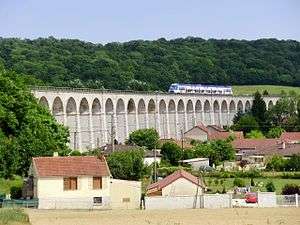Paris-Est–Mulhouse-Ville railway
The railway from Paris-Est to Mulhouse-Ville is a 491-kilometre long railway line, that connects Paris to Mulhouse via Troyes, Chaumont and Belfort, France. The railway was opened in several stages between 1848 and 1858.[2]
Route
The Paris–Mulhouse railway leaves the Gare de l'Est in Paris in eastern direction. At Noisy-le-Sec, where the Paris–Strasbourg railway branches off, it turns south. It crosses the river Marne at Nogent-sur-Marne, and turns southeast. Near Gouaix it reaches the river Seine, and follows this river upstream, until Nogent-sur-Seine on its right bank, then on its left bank, roughly southeastward. At Troyes it crosses the Seine again, and turns east.
It enters the Aube valley near Jessains, and continues upstream along Bar-sur-Aube. It leaves the Aube and enters the upper Marne valley at Chaumont. It passes Langres and the railway junction Culmont-Chalindrey, where it crosses the line Nancy–Dijon. It reaches the river Saône at Jussey, and follows it downstream until Port-sur-Saône, where it turns southeast to reach Vesoul. It turns east, passing Lure, Belfort, Dannemarie and Altkirch. Here it turns northeast and enters its terminus Mulhouse.
Main stations
The main stations on the Paris–Mulhouse railway are:
- Gare de l'Est, Paris
- Gare de Troyes
- Gare de Culmont-Chalindrey
- Gare de Belfort
- Gare de Mulhouse
History
The construction and exploitation of a railway from Paris to Mulhouse was conceded to the newly formed Chemins de fer de l'Est in 1853.[3] The first section that was opened in 1848 led from Flamboin-Gouaix to Troyes, and was part of a railway from Montereau-Fault-Yonne to Troyes. The section from Paris to Noisy-le-Sec was opened in 1849, as a part of the Paris–Strasbourg railway. In 1856 a line from Noisy-le-Sec to Nogent-sur-Marne was built. The sections between Nogent-sur-Marne and Flamboin-Gouaix, between Troyes and Langres, and between Dannemarie and Mulhouse were opened in 1857. Finally in 1858 the section between Langres and Dannemarie was opened.[2]
Services
The Paris–Mulhouse railway is used by the following passenger services:
- TGV on the section from Paris to Noisy-le-Sec
- Intercités Paris–Belfort
- TER Champagne-Ardenne, TER Franche-Comté and TER Alsace regional services on the whole line
- Transilien regional services on the section between Paris and Longueville
- RER E Paris rapid transit on the section between Paris and Gretz-Armainvilliers
References
- "RFF - Map of electrified railway lines" (PDF).
- Direction Générale des Ponts et Chaussées et des Chemins de Fer (1869). Statistique centrale des chemins de fer. Chemins de fer français. Situation au 31 décembre 1869 (in French). Paris: Ministère des Travaux Publics. pp. 146–160.
- Joanne, Adolphe (1859). Atlas historique et statistique des chemins de fer français (in French). Paris: L. Hachette. p. 39.
